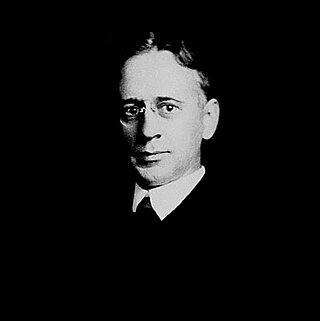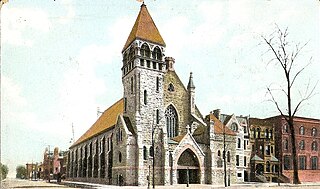Related Research Articles

A crucifer or cross-bearer is, in some Christian churches, a person appointed to carry the church's processional cross, a cross or crucifix with a long staff, during processions at the beginning and end of the service.

The invitatory is the psalm used to start certain daily prayer offices in Catholic and Anglican traditions. Most often it is Psalm 94(95), also known as the Venite. The term derives from Medieval Latin invītātōrium, derived from invītāre, "to invite."

Daniel Sylvester Tuttle was consecrated a bishop of the Episcopal Church in 1866. His first assignment was as Bishop of Montana, a missionary field that included Montana, Utah, and Idaho.
Francis Joseph Hall (1857–1932) was an American Episcopal theologian and priest in the Anglo-Catholic tradition. Hall was one of the first to attempt an Anglican systematic theology.

The Episcopal Diocese of Nebraska is the diocese of the Episcopal Church in the United States of America with jurisdiction over the state of Nebraska. It is in Province VI. Its cathedral, Trinity Episcopal Cathedral, is in Omaha, as are the diocese's offices. As of 2019, the diocese contains 52 congregations and 7,096 members. Average Sunday attendance is approximately 2,418 across the diocese.
The Episcopal Peace Fellowship (EPF) is an American peace organization composed of members of the Episcopal Church.
Massey Hamilton Shepherd Jr. was an American priest and scholar of the Episcopal Church. A prominent liturgist, he was one of the few American members of other Christian churches honored with an invitation to observe the Second Vatican Council of the Roman Catholic Church in the 1960s. He served on the Episcopal Church's Standing Liturgical Commission from 1947 to 1976 and was a leading figure in developing the 1979 Book of Common Prayer used by the Episcopal Church.
The Church Review and Ecclesiastical Register was an Episcopal American journal publishing on theological and religious matters from 1848 until 1891. The journal was founded by Nathaniel Smith Richardson. It was initially published in New Haven and became one of the leading publications in the American Episcopal Church. It was quarterly, monthly, and bimonthly during its publication history. The journal stopped publishing in 1891.

The National Episcopal Historians and Archivists (NEHA) is an organization that encourages every congregation, diocese, and organization in the Episcopal Church in the United States of America to collect, preserve and organize its records and share its history.

St. Mark's Pro-Cathedral is an Episcopal Church building located in Hastings, Nebraska, United States. It has been listed on the National Register of Historic Places since 1987. In 2020, it reported 247 members, average attendance of 64, and $120,307 in plate and pledge financial support.

Joseph Cruikshank Talbot was the missionary bishop of the Northwest and the third bishop of the Episcopal Diocese of Indiana.

George Maxwell Randall was the Episcopal bishop of Missionary District of Colorado and Parts Adjacent.

William Palmer Ladd (1870–1941) was an American Episcopal priest, liturgical scholar, and seminary dean.

William David Walker was consecrated as the first missionary bishop of the Episcopal Church's Missionary District of North Dakota on December 20, 1883. He became the third bishop of Western New York in 1897 and held this position until his death in 1917.
The Worker Sisters of the Holy Spirit (WSHS) is an international covenant community in the Episcopal Church which offers women, regardless of marital status, a path for spiritual growth. It is a registered charity.

Charles Sanford Olmsted was a bishop of the Episcopal Diocese of Colorado from 1902 to 1918. He was the first bishop elected by the Diocese of Colorado after it became an independent diocese.
The Union of Black Episcopalians, formerly the Union of Black Clergy and Laity, is an organization of The Episcopal Church.

The 1979 Book of Common Prayer is the official primary liturgical book of the U.S.-based Episcopal Church. An edition in the same tradition as other versions of the Book of Common Prayer used by the churches within the Anglican Communion and Anglicanism generally, it contains both the forms of the Eucharistic liturgy and the Daily Office, as well as additional public liturgies and personal devotions. It is the fourth major revision of the Book of Common Prayer adopted by the Episcopal Church, and succeeded the 1928 edition. The 1979 Book of Common Prayer has been translated into multiple languages and is considered a representative production of the 20th-century Liturgical Movement.
Paul Axtell Kellogg was a diocesan bishop in the Episcopal Church who served in the Dominican Republic from 1960 until his retirement in 1972.

Christ Reformed Episcopal Church was a church in Chicago that became a founding member of the Reformed Episcopal Church (REC) in 1873. From around 1860 until its demolition in 1920, the church occupied a Victorian Gothic building on South Michigan Avenue. In addition to its role in REC history, the church was also noted for its Tiffany stained glass windows, many of which survived in different locations.
References
- ↑ Don S. Armentrout and Robert Boak Slocum (ed.), "Western Nebraska, Missionary District of", An Episcopal Dictionary of the Church, A User Friendly Reference for Episcopalians, The Episcopal Church Center
- ↑ Don S. Armentrout and Robert Boak Slocum (ed.), "Nebraska, Diocese of", An Episcopal Dictionary of the Church, A User Friendly Reference for Episcopalians, The Episcopal Church Center